
Ready to get certified?
Free CDCES Coach App

Subscribe
eNewsletter
Download
Free Med Pocket Cards
Simplifying Insulin Delivery with CeQur Simplicity

The American Diabetes Association estimates that over 8 million people in the United States depend on insulin therapy for survival.¹ Multiple daily injections (MDI) of insulin can be challenging to manage. Diabetes care and education specialists understand that complex medication regimens often lead to difficulty achieving medication adherence and worsening glycemic control.²
CeQur Simplicity is a unique alternative to MDI therapy. It redefines insulin delivery with a wearable device that administers insulin with just a few clicks. By simplifying insulin delivery, CeQur can support successful insulin management and improve glycemic control without the hassle of multiple daily injections.
What is CeQur Simplicity?
The CeQur Simplicity patch is a wearable insulin delivery device for adults aged 21 and older, approved for individuals with type 1 or type 2 diabetes who require insulin. This thin patch can hold up to 200 units of either U-100 lispro (Humalog) or U-100 aspart (Novolog) insulin. The patch can be used for up to 4 days on any approved insulin injection site. It is usually worn on the abdomen, thigh, or upper arms, as these areas are more accessible for reaching the CeQur device.³
Pressing the buttons on the sides of the device delivers two units of insulin. Each press produces an audible click to announce delivery. Over the 4-day wear period, this wearable insulin device replaces up to twelve meal bolus injections. The ease of use and ability to dose without carrying and storing insulin or injecting it can be freeing for many people living with diabetes. Research has found that when using the CeQur patch, users were more satisfied with the device, experienced less diabetes-related burden, and missed fewer insulin boluses.
CeQur is not an automated insulin delivery system. This device operates independently and does not connect to continuous glucose monitors. The CeQur Simplicity is not approved for basal insulin and does not replace the need for basal insulin.
Who is an Ideal Candidate for CeQur Simplicity?
Diabetes healthcare professionals can help identify clients who may benefit from the CeQur Simplicity insulin patch. An ideal CeQur candidate may be those who:
- Feel overwhelmed by technology
- Have anxiety related to injections or are experiencing injection fatigue
- Want a less complicated routine
- Are frustrated with always carrying insulin pens and supplies
- Want a discreet wearable device
- Are unhappy with their current MDI therapy
The Diabetes Healthcare Perspective
The healthcare professional’s (HCP) role starts with explaining the CeQur Simplicity device and how it differs from traditional insulin pumps and insulin pens. Besides identifying those who may benefit from CeQur, the HCP also provides training and troubleshooting for CeQur. CeQur training includes demonstrating how to apply and remove the device, using the click-based bolus feature, and performing site care and rotation procedures. This hands-on education helps clients build confidence in their new insulin delivery device. HCP’s can also assist in exploring cost, insurance coverage, and manufacturer support programs.
Here are other considerations for the diabetes healthcare professional:
✅ Assess the ability to count by 2s as the device only delivers doses in increments of 2 units.
✅ Fill the CeQur device with insulin just before use and never prefilled in advance.
✅ Do not apply a CeQur insulin patch near the area where basal insulin is injected.
✅ Avoid applying the insulin patch to areas that will be irritated by clothing, accessories, or a seat belt.
✅ Use the ‘Change By’ sticker provided with each device as a reminder of when the device needs to be changed.
✅ Avoid submerging the patch more than 3 feet 3 inches (1 meter). Also, do not squeeze the dosing buttons while the patch is underwater.³
Diabetes healthcare professionals work to identify and address barriers to insulin therapy. Collaborating with clients can boost their confidence, foster effective diabetes self-management, and improve their psychological outcomes. For those who are frustrated with their current MDI therapy but are also leery of AID systems, the CeQur Simplicity insulin patch may offer fewer injections, freedom from carting around meal-time insulin, and an improved quality of life.
References
- American Diabetes Association. (2022, June 22). American Diabetes Association announces support for INSULIN act at senate press conference. [Press Release]. https://diabetes.org/newsroom/american-diabetes-association-announces-support-for-insulin-act-at-senate-press-conference
- Ab Rahman, N., Lim, M. T., Thevendran, S., Ahmad Hamdi, N., & Sivasampu, S. (2022). Medication regimen complexity and medication burden among patients with Type 2 Diabetes Mellitus: A retrospective analysis. Frontiers in Pharmacology, 13, 808190. https://www.frontiersin.org/journals/pharmacology/articles/10.3389/fphar.2022.808190/full
- CeQur Simplicity. (n.d.). Resources & support. Retrieved September 1, 2025, from https://myceqursimplicity.com/resources-support/
Cyber Weekend Sale - 30% off all Online Programs
Save the dates - November 30th to December 2nd

“From November 30th to December 2nd, use the code “Cyber30″ for 30% off at checkout!
Save the date to shop our sale!
Question of the Week | RT Forgot Their Insulin- Best Response?
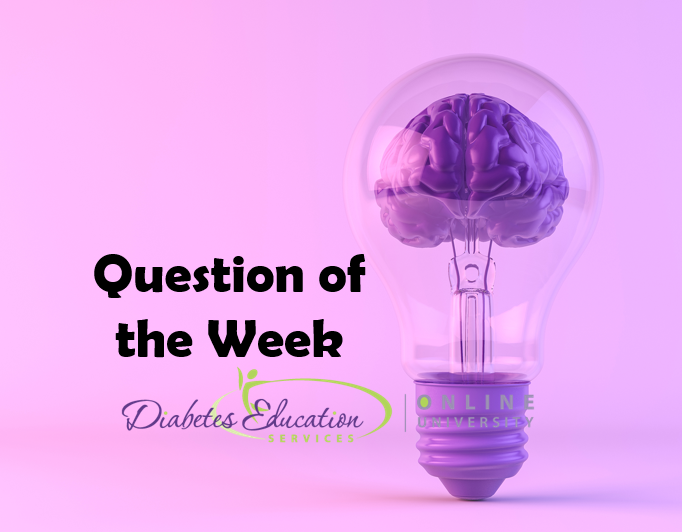
RT has type two diabetes and has been maintaining a time and range of 70% or greater. However, when they show up at the office, the last week’s time in range dropped to 30%. You ask what was different this week from the previous few months. RT tells you they went on a five day fishing trip and forgot their insulin.
What’s the best response?
- Next time, make sure to take your insulin and put it in the refrigerator for safekeeping.
- Before we dive into the diabetes stuff, tell me about your fishing trip.
- I’m worried that you’re going get complications due to high blood glucose levels.
- I’m just relieved you did not go into diabetes ketoacidosis.
Cyber Weekend Sale
Get 30% Off Our Entire Collection of Online University Courses
Course credits through AMA PRA Category 1 Credits™, ACPE, ANCC, and CDR!
Join us November 19th at 11:30 AM PST

Level 5 | Beyond Blood Glucose: Empowering Health Through a Holistic Lens with:
Speaker Nick Kundrat, BS, CEP, CDCES, LMT
Rationale of the Week | FIB-4 of 2.83. What Action Required?
For last week’s practice question, we quizzed participants on FIB-4 of 2.83. 48.09% of respondents chose the best answer. We want to clarify and share this important information, so you can pass it on to people living with diabetes and your colleagues, plus prepare for exam success!
Before we start though, if you don’t want any spoilers and haven’t tried the question yet, you can answer it below: Answer Question
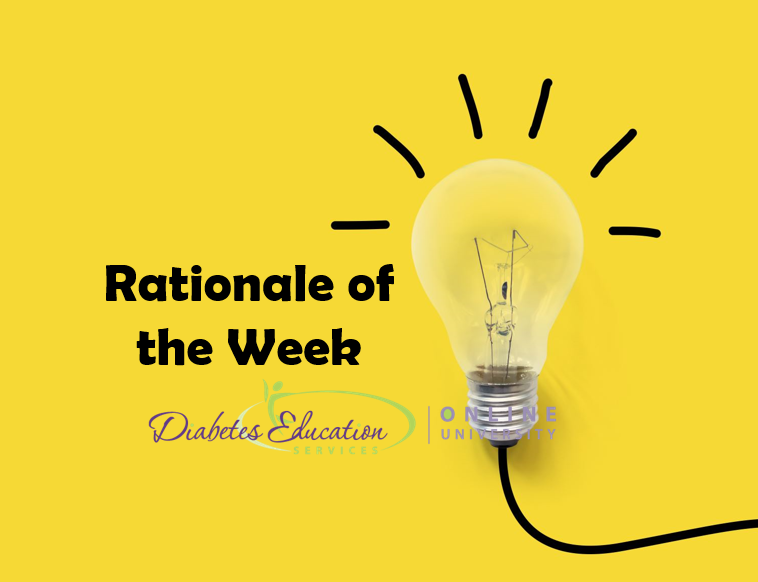
AR lives with type 2 diabetes, and their waistline is 41 inches. Since their ALT and AST levels are elevated, you know they are at risk for steatosis (MASH). You quickly calculate their Fibrosis-4 Index (FIB-4), by plugging in AR’s Age, AST, ALT, platelet count into the FIB-4 calculator. AR’s result is 2.83.
According to the ADA Standards, with a FIB-4 value of 2.83, which action is required?
- Start AR on pioglitazone and recheck FIB-4 in 3 months.
- Encourage AR to see a RDN and stop consumption of alcohol immediately.
- Suggest increased high intensity activity coupled with a GLP-1 to reduce body weight.
- Refer AR to liver specialist for further evaluation.

Getting to the Best Answer
Answer A is incorrect: 18.4% chose this answer, “Start AR on pioglitazone and recheck FIB-4 in 3 months.” Although pioglitazone is a recommended treatment for steatosis, since AR’s FIB- is greater than 2.67, this indicates AR is at high risk for advanced fibrosis and a referral to a liver specialist is warranted.
Answer B is incorrect: 15.11% chose this answer, “Encourage AR to see a RDN and stop consumption of alcohol immediately.” Seeing a RDN is very important for AR to evaluate and customize an eating plan to address their steatosis and support quality of life. However, since AR’s FIB- is greater than 2.67, this indicates AR is at high risk for advanced fibrosis and a referral to a liver specialist is warranted.
Answer C is incorrect: 18.4% chose this answer, “Suggest increased high intensity activity coupled with a GLP-1 to reduce body weight.” Strength training and activity, coupled with a GLP-1 for GLP-1/GIP are important strategies to address steatosis. However, since AR’s FIB- is greater than 2.67, this indicates AR is at high risk for advanced fibrosis and a referral to a liver specialist is warranted.
Answer D is correct: 48.09% chose this answer, “Refer AR to liver specialist for further evaluation.” Great job! AR will require intensive intervention to decrease their risk of worsening steatosis, including MNT, targeted activities, and a referral to a liver specialist to determine the best treatment approach.
We hope you appreciate this week’s rationale! Thank you so much for taking the time to answer our Question of the Week and participate in this fun learning activity!
Cyber Weekend Sale!
Get 30% Off Our Entire Collection of Online University Courses
Course credits through AMA PRA Category 1 Credits™, ACPE, ANCC, and CDR!
Updates in Lifestyle Therapy for MASLD and MASH

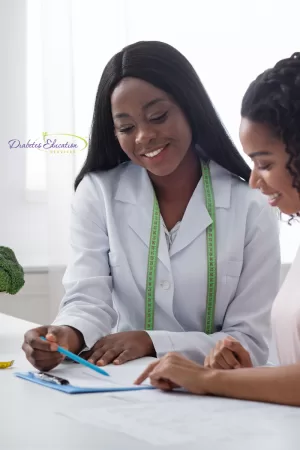
Metabolic Dysfunction-Associated Steatotic Liver Disease (MASLD) and metabolic dysfunction-associated steatohepatitis (MASH) are now recognized as high-risk health conditions for people living with diabetes.
Two out of three individuals with type 2 diabetes are affected by liver steatosis.¹ In May 2025, the American Diabetes Association (ADA) published a consensus report, which emphasized recommendations for early diagnosis, long-term monitoring, and highlighted lifestyle interventions as critical in preventing progression to cirrhosis.¹
In the past year, two medications have been approved for the treatment of MASH; however, lifestyle change remains at the foundation of treatment. These changes focus on improving dietary quality, increasing physical activity, promoting weight loss, and reducing sedentary behaviors.
Nutrition Therapy Approaches
Nutrition therapy, ideally guided by a registered dietitian nutritionist and reinforced by the entire diabetes care team, needs to be individualized to each person’s social, cultural, and financial needs.¹ Ivancovsky Wajcman et al. ² published a fascinating review of different country’s MASLD management guidelines summarizing recommended lifestyle interventions, their findings indicated many similarities with only a few differences.
Most groups recommended evidence-based eating patterns with the following themes:
- High in fiber and focused on whole food consumption, while reducing saturated fat, added sugars, and ultra-processed foods.¹
- Reduction of commercially produced fructose consumption was recommended as high fructose intake has been associated with greater fibrosis severity, independent of total calorie intake.
- A few guidelines specifically called out reduction/avoidance of regular soda consumption emphasizing that consuming more than four servings of regular sodas per week was associated with a 45% higher risk of developing MASLD. ³
- In contrast, coffee consumption, whether caffeinated or not, has been shown in meta-analyses to reduce MASLD risk when intake exceeds three cups per day. Guidelines suggested consumption of greater than 2-3 cups per day. (Can I get a whoot for my daily coffee habit).
- Similar to the ADA Standards of Care for diabetes management, focusing on shifting towards water consumption and reducing the consumption of sugar-sweetened beverages has shown improved outcomes.
Other Recommended Eating Patterns & Physical Activity
The Mediterranean diet eating pattern is recommended in the MASLD/MASH ADA consensus report as well as the EASL–EASD–EASO Clinical Practice Guidelines ¹,²,³ due to its relationship with improving diet quality and evidence of hepatic and cardiovascular health benefits, even without weight loss.
Other dietary patterns, such as the low-fat, low-carbohydrate, Dietary Approaches to Stop Hypertension, high protein, meal replacement, and intermittent fasting, have also been shown to be comparable strategies to improve steatosis due to weight loss.¹
In people with overweight and obesity, the magnitude of weight loss has been associated with improving glycemic management, insulin sensitivity, as well as histological improvements in MASH.¹
Weight reduction over 5% has been associated with reduced steatosis, and greater weight loss of 7-10% has been shown to reverse steatohepatitis and liver fibrosis.¹,²,³ However, it is recognized that achieving long-term weight reduction may be challenging.³
Avoidance of alcohol is recommended for individuals with moderate fibrosis, as even modest use may aggravate injury.
Physical Activity, Stress Reduction & Sleep
Physical activity, including aerobic and resistance training, has independent effects beyond weight loss: decreasing intrahepatic fat, improving cardiovascular risk, improving insulin sensitivity, and supporting weight‐loss maintenance. Guidelines generally recommend greater than or equal to 150 minutes per week of moderate intensity (or equivalent) and resistance activities 2-3 times per week, with greater benefit when increasing activity.
However, reducing sedentary time and breaking up prolonged sitting bouts can be effective ways to reach this goal.¹,³ Emerging evidence highlights the importance of stress reduction, adequate sleep and treatment of sleep apnea, and management of comorbidities such as dyslipidemia and hypertension, due to their impact on liver steatosis, inflammation, and fibrosis.¹,²
FDA-Approved Medications
Until recently, there were no FDA-approved medications specifically for MASH; treatment was either off-label or targeted at comorbidities such as weight reduction or lipid and glycemic management. However, in the past 2 years, two different medications have been released to address MASH. In March 2024, the FDA approved resmetirom (brand name Rezdiffra) for adults with noncirrhotic MASH to be prescribed in conjunction with lifestyle therapy. 4 In August 2025, the FDA approved semaglutide (brand name Wegovy) for the treatment of MASH and moderate to advanced liver fibrosis. 5
MASLD and MASH
MASLD and MASH are high-risk health conditions for people with diabetes, with approximately 10-30% progressing to advanced liver disease, including cirrhosis.³ While new FDA-approved medications such as resmetirom and semaglutide offer promising options, lifestyle modification remains a cornerstone treatment.
As diabetes healthcare professionals, we are uniquely positioned to implement evidence-based strategies into the individualized care plan.
We can screen, educate, and empower individuals living with diabetes to take proactive steps that protect liver health, improve metabolic outcomes, and prevent progression to cirrhosis. Through nutrition and lifestyle therapy, pharmacotherapy, and incorporating broad strategies into DSMES services (¹) we can strengthen prevention and outcomes.
References
- Cusi K, Abdelmalek MF, Apovian CM, et al. Metabolic Dysfunction–Associated Steatotic Liver Disease (MASLD) in people with diabetes: the need for screening and early intervention. A consensus report of the American Diabetes Association. Diabetes Care.
2025;48(7):1057-1082. doi:10.2337/dci24-0094 - Ivancovsky Wajcman D, Byrne CJ, Dillon JF, et al. A narrative review of lifestyle management guidelines for metabolic dysfunction-associated steatotic liver disease. Hepatology. Published online August 15, 2024.doi:10.1097/HEP.0000000000001058
- Tacke F, et al. EASL–EASD–EASO clinical practice guidelines on the management of metabolic dysfunction–associated steatotic liver disease (MASLD). J Hepatol. 2024;81(3):492-542.doi:10.1016/j.jhep.2024.05.010
- US Food and Drug Administration. FDA approves first treatment for patients with liver scarring due to fatty liver disease. Published March 14, 2024. Accessed September 19, 2025. https://www.fda.gov/news-events/press-announcements/fda-approves-first-treatment-patients-liver-scarring-due-fatty-liver-disease
- US Food and Drug Administration. FDA approves treatment for serious liver disease known
as “MASH.” Published March 14, 2024. Accessed September 19, 2025. https://www.fda.gov/drugs/news-events-human-drugs/fda-approves-treatment-serious-liver-disease-known-mash
Get 30% Off Your Entire Order
From November 30th to December 2nd, use the code “Cyber30″ for 30% off at checkout!
Question of the Week | Diabetes Tech and Diabetes Distress

Kyle is a 55-year-old man with type 2 diabetes for ten years. He was recently diagnosed with retinopathy in both eyes. His grandmother lost her eyesight due to diabetes. Due to this family history, he is very concerned about his new diagnosis. He uses a Libre continuous glucose monitor (CGM) to monitor his blood sugar levels. During your visit, he is preoccupied with checking his Libre CGM and tells you that he uses his glucometer to verify CGM readings at least four to six times per day. When you ask him about this, he reports that he can’t focus on his work or home life if he isn’t over 90% time in range.
As a diabetes care and education specialist, what is the best approach to this situation?
- Reassure Kyle that retinopathy is very common with type 2 diabetes. Encourage him to verify the CGM with his glucometer more frequently if that helps make him feel less anxious.
- Educate Kyle that the CGM he is using cannot be calibrated and instruct him to stop using his glucometer, since the CGM is accurate.
- Acknowledge Kyle’s fears about vision loss, screen for diabetes distress, and collaborate on strategies to reduce the emotional burden of CGM use, including referral to a behavioral health provider if indicated.
- Adjust Kyle’s time in range target goal to >90% to meet his expectations and reduce his worry about complications.
Rationale of the Week | Which Treatment is FDA Approved for MASH?
For last week’s practice question, we quizzed participants on FDA approved treatment for MASH. 33.75% of respondents chose the best answer. We want to clarify and share this important information, so you can pass it on to people living with diabetes and your colleagues, plus prepare for exam success!
Before we start though, if you don’t want any spoilers and haven’t tried the question yet, you can answer it below: Answer Question

MJ just discovered that in addition to their type 2 diabetes and a BMI of 31, they also have MASH.
Based on this diagnosis, which FDA approved medication would help address their steatosis?
-
Semaglutide (Ozempic)
-
Empagliflozin (Jardiance)
-
Tirzepatide (Mounjaro)
- Semaglutide (Wegovy)
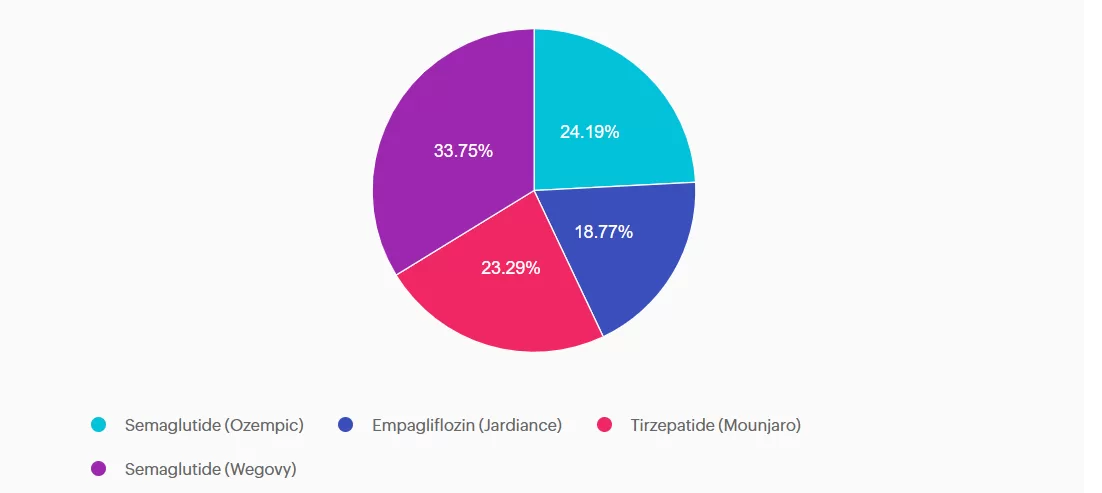
Getting to the Best Answer
Answer A is incorrect: 24.19% chose this answer, “Semaglutide (Ozempic).” The diabetes approved version of semaglutide (Ozempic) does not yet have FDA approval as a medication that is used for treatment of MASH.
Answer B is incorrect: 18.77% chose this answer, “Empagliflozin (Jardiance).” Although empagliflozin will reduce blood glucose and can help with weight loss, it is not FDA approved for treatment of MASH.
Answer C is incorrect: 23.29% chose this answer, “Tirzepatide (Mounjaro).” Tirzepatide (Mounjaro) is approved for treatment of diabetes, helps with weight loss and is FDA approved for sleep apnea. However it is not FDA approved for treatment of MASH.
Answer D is correct: 33.75% chose this answer, “Semaglutide (Wegovy).” The weight loss approved version of semaglutide (Wegovy) has FDA approval as a medication that is used for treatment of MASH.
Please see our new “Indications for GLP-1/GIP” Cheat Sheet for a complete run down.
We hope you appreciate this week’s rationale! Thank you so much for taking the time to answer our Question of the Week and participate in this fun learning activity!
Join us live in San Diego Next Week - 6 Seats Left

It’s Not Too Late to Register!
Get ready for certification & take your practice to the next level.
October 22nd – 23rd, 2025
DiabetesEd Training Seminar
30+ CEs with Expanded Accreditation!

Join our expert team for engaging, interactive sessions that bring the ADA Standards of Care to life—covering medications, behavior change, technology, and more. Ideal for CDCES or BC-ADM exam prep, this course also includes a 4-hour Virtual Medical Nutrition Therapy Toolkit and bonus content that also meets CDCES renewal requirements.
Program Objectives:
Upon completion of this activity, participants should be able to:
- Describe the current ADA Standards for diagnosis, goals, and person-centered diabetes management across the lifespan.
- Demonstrate insulin pattern management and dosing strategies in clinical scenarios.
- Implement timely screening and risk reduction strategies for microvascular and cardiovascular complications.
- Incorporate behavior change techniques and medical nutrition therapy to support people with diabetes self-management and lifestyle adjustment.
Expert Faculty:

Diana Isaacs, PharmD, BCPS, BCACP, CDCES, BC-ADM, FADCES, FCCPCES

Beverly Thomassian, RN, MPH, CDCES, BC-ADM
Faculty Bios & Disclosures
Our expert team transforms complex diabetes science into clear, practical insights—keeping it real, engaging, and fun!
Program Faculty Disclosures:
Partners for Advancing Clinical Education (Partners) requires every individual in a position to control educational content to disclose all financial relationships with ineligible companies that have occurred within the past 24 months. Ineligible companies are organizations whose primary business is producing, marketing, selling, re-selling, or distributing healthcare products used by or on patients.
All relevant financial relationships for anyone with the ability to control the content of this educational activity are listed below and have been mitigated according to Partners policies. Others involved in the planning of this activity have no relevant financial relationships.
Faculy Bios & Disclosures:
 Coach Beverly Thomassian RN, MPH, CDCES, BC-ADM – CEO of DiabetesEd Services
Coach Beverly Thomassian RN, MPH, CDCES, BC-ADM – CEO of DiabetesEd ServicesDisclosures:
Beverly Thomassian has no financial disclosures
Bio:
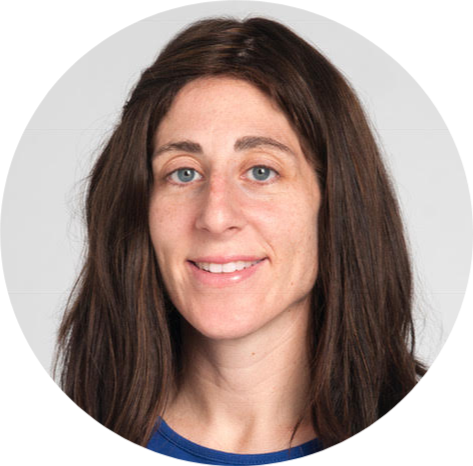 Diana Isaacs, PharmD, BCPS, BCACP, CDCES, BC-ADM, FADCES, FCCPCES
Diana Isaacs, PharmD, BCPS, BCACP, CDCES, BC-ADM, FADCES, FCCPCES
Disclosures:
Dr. Diana Isaacs has the following relevant financial relationships:
- Consultant, advisor, and speaker for Abbot Labratories, Dexcom, Medtronic, Insulet, Lilly, Cequr, Sanofi, and Undermyfork
- Board member at Association for Diabetes Care and Education Specialists
Bio:
Diana Isaacs was awarded 2020 ADCES Diabetes Educator of the Year for her educational platform promoting the use of CGM for people with diabetes and other innovations. She serves in leadership roles for several pharmacies and diabetes organizations. She has numerous diabetes publications and research projects with a focus on medications, CGM and diabetes technology.
For the past three year, Dr. Isaacs has served as a contributing author for the 2023 ADA Standards of Care.
As the Program Coordinator and clinical pharmacist specialist in the Cleveland Clinic Diabetes Center, Dr. Isaacs brings a wealth of clinical knowledge combined with extensive research and speaking experience to this program.
Expanded Accreditation
Activity Start and End Date: 10/22/25 – 10/23/2025
Estimated time to complete the activity: 15 hours and 30 minutes
_____________________________________
Jointly provided by Partners for Advancing Clinical Education and Diabetes Education Services
![]()
![]()
Joint Accreditation Statement:
 In support of improving patient care, this activity has been planned and implemented by Partners for Advancing Clinical Education (Partners) and Diabetes Education Services. Partners is jointly accredited by the Accreditation Council for Continuing Medical Education (ACCME), the Accreditation Council for Pharmacy Education (ACPE), and the American Nurses Credentialing Center (ANCC), to provide continuing education for the healthcare team.
In support of improving patient care, this activity has been planned and implemented by Partners for Advancing Clinical Education (Partners) and Diabetes Education Services. Partners is jointly accredited by the Accreditation Council for Continuing Medical Education (ACCME), the Accreditation Council for Pharmacy Education (ACPE), and the American Nurses Credentialing Center (ANCC), to provide continuing education for the healthcare team.
Physician Continuing Education:
Partners designates this enduring material for a maximum of 15.50 AMA PRA Category 1 Credit(s)™. Physicians should claim only the credit commensurate with the extent of their participation in the activity.
Nursing Continuing Professional Development:
The maximum number of hours awarded for this Nursing Continuing Professional Development activity is 15.50 contact hours.
Pharmacy Continuing Education:
Partners designates this continuing education activity for 15.50 contact hour(s) (1.550 CEUs) of the Accreditation Council for Pharmacy Education.
(Universal Activity Number – JA4008073-9999-25-206-L01-P)
Type of Activity: Application
For Pharmacists: Upon successfully completing the activity evaluation form, transcript information will be sent to the NABP CPE Monitor Service within 4 weeks.
Dietitian Continuing Education:
This program offers 15.50 CPEUs for dietitians.
Interprofessional Continuing Education:
![]() This activity was planned by and for the healthcare team, and learners will receive 15.50 Interprofessional Continuing Education (IPCE) credit for learning and change.
This activity was planned by and for the healthcare team, and learners will receive 15.50 Interprofessional Continuing Education (IPCE) credit for learning and change.
For additional information about the accreditation of this activity, please visit https://partnersed.com.
The use of DES products does not guarantee the successful passage of the certification exam. CBDCE and ADCES do not endorse any preparatory or review materials for the CDCES or BC-ADM exams, except for those published by CBDCE & ADCES.
Question of the Week | FIB-4 of 2.83. What Action Required?

AR lives with type 2 diabetes, and their waistline is 41 inches. Since their ALT and AST levels are elevated, you know they are at risk for steatosis (MASH). You quickly calculate their Fibrosis-4 Index (FIB-4), by plugging in AR’s Age, AST, ALT, platelet count into the FIB-4 calculator. AR’s result is 2.83.
According to the ADA Standards, with a FIB-4 value of 2.83, which action is required?
- Start AR on pioglitazone and recheck FIB-4 in 3 months.
- Encourage AR to see a RDN and stop consumption of alcohol immediately.
- Suggest increased high intensity activity coupled with a GLP-1 to reduce body weight.
- Refer AR to liver specialist for further evaluation.
Click Here to Test your Knowledge
Learn More About this Question at our DiabetesEd Training
Join us live in San Diego Next Week – 6 Seats Left
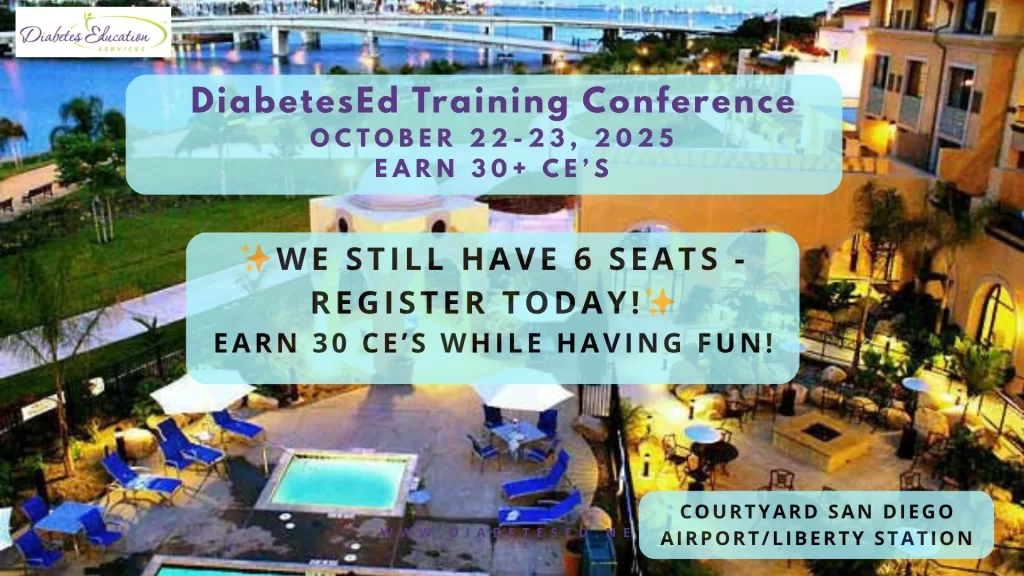
ITS NOT TOO LATE TO REGISTER- Get ready for Certification & take your practice to the next level!
DiabetesEd Training Seminar
Earn 30+ CEs with Expanded Accreditation!
Join our expert team for engaging, interactive sessions that bring the ADA Standards of Care to life—covering medications, behavior change, technology, and more. Ideal for CDCES or BC-ADM exam prep, this course also includes a 4-hour Virtual Medical Nutrition Therapy Toolkit and bonus content that also meets CDCES renewal requirements.

Program Objectives:
Upon completion of this activity, participants should be able to:
- Describe the current ADA Standards for diagnosis, goals, and person-centered diabetes management across the lifespan.
- Demonstrate insulin pattern management and dosing strategies in clinical scenarios.
- Implement timely screening and risk reduction strategies for microvascular and cardiovascular complications.
- Incorporate behavior change techniques and medical nutrition therapy to support people with diabetes self-management and lifestyle adjustment.
Expert Faculty:

Diana Isaacs, PharmD, BCPS, BCACP, CDCES, BC-ADM, FADCES, FCCPCES

Beverly Thomassian, RN, MPH, CDCES, BC-ADM
Faculty Bios & Disclosures
Our expert team transforms complex diabetes science into clear, practical insights—keeping it real, engaging, and fun!
Program Faculty Disclosures:
Partners for Advancing Clinical Education (Partners) requires every individual in a position to control educational content to disclose all financial relationships with ineligible companies that have occurred within the past 24 months. Ineligible companies are organizations whose primary business is producing, marketing, selling, re-selling, or distributing healthcare products used by or on patients.
All relevant financial relationships for anyone with the ability to control the content of this educational activity are listed below and have been mitigated according to Partners policies. Others involved in the planning of this activity have no relevant financial relationships.
Faculy Bios & Disclosures:
 Coach Beverly Thomassian RN, MPH, CDCES, BC-ADM – CEO of DiabetesEd Services
Coach Beverly Thomassian RN, MPH, CDCES, BC-ADM – CEO of DiabetesEd ServicesDisclosures:
Beverly Thomassian has no financial disclosures
Bio:
 Diana Isaacs, PharmD, BCPS, BCACP, CDCES, BC-ADM, FADCES, FCCPCES
Diana Isaacs, PharmD, BCPS, BCACP, CDCES, BC-ADM, FADCES, FCCPCES
Disclosures:
Dr. Diana Isaacs has the following relevant financial relationships:
- Consultant, advisor, and speaker for Abbot Labratories, Dexcom, Medtronic, Insulet, Lilly, Cequr, Sanofi, and Undermyfork
- Board member at Association for Diabetes Care and Education Specialists
Bio:
Diana Isaacs was awarded 2020 ADCES Diabetes Educator of the Year for her educational platform promoting the use of CGM for people with diabetes and other innovations. She serves in leadership roles for several pharmacies and diabetes organizations. She has numerous diabetes publications and research projects with a focus on medications, CGM and diabetes technology.
For the past three year, Dr. Isaacs has served as a contributing author for the 2023 ADA Standards of Care.
As the Program Coordinator and clinical pharmacist specialist in the Cleveland Clinic Diabetes Center, Dr. Isaacs brings a wealth of clinical knowledge combined with extensive research and speaking experience to this program.
Expanded Accreditation
Activity Start and End Date: 10/22/25 – 10/23/2025
Estimated time to complete the activity: 15 hours and 30 minutes
_____________________________________
Jointly provided by Partners for Advancing Clinical Education and Diabetes Education Services
![]()
![]()
Joint Accreditation Statement:
 In support of improving patient care, this activity has been planned and implemented by Partners for Advancing Clinical Education (Partners) and Diabetes Education Services. Partners is jointly accredited by the Accreditation Council for Continuing Medical Education (ACCME), the Accreditation Council for Pharmacy Education (ACPE), and the American Nurses Credentialing Center (ANCC), to provide continuing education for the healthcare team.
In support of improving patient care, this activity has been planned and implemented by Partners for Advancing Clinical Education (Partners) and Diabetes Education Services. Partners is jointly accredited by the Accreditation Council for Continuing Medical Education (ACCME), the Accreditation Council for Pharmacy Education (ACPE), and the American Nurses Credentialing Center (ANCC), to provide continuing education for the healthcare team.
Physician Continuing Education:
Partners designates this enduring material for a maximum of 15.50 AMA PRA Category 1 Credit(s)™. Physicians should claim only the credit commensurate with the extent of their participation in the activity.
Nursing Continuing Professional Development:
The maximum number of hours awarded for this Nursing Continuing Professional Development activity is 15.50 contact hours.
Pharmacy Continuing Education:
Partners designates this continuing education activity for 15.50 contact hour(s) (1.550 CEUs) of the Accreditation Council for Pharmacy Education.
(Universal Activity Number – JA4008073-9999-25-206-L01-P)
Type of Activity: Application
For Pharmacists: Upon successfully completing the activity evaluation form, transcript information will be sent to the NABP CPE Monitor Service within 4 weeks.
Dietitian Continuing Education:
This program offers 15.50 CPEUs for dietitians.
Interprofessional Continuing Education:
![]() This activity was planned by and for the healthcare team, and learners will receive 15.50 Interprofessional Continuing Education (IPCE) credit for learning and change.
This activity was planned by and for the healthcare team, and learners will receive 15.50 Interprofessional Continuing Education (IPCE) credit for learning and change.
For additional information about the accreditation of this activity, please visit https://partnersed.com.
The use of DES products does not guarantee the successful passage of the certification exam. CBDCE and ADCES do not endorse any preparatory or review materials for the CDCES or BC-ADM exams, except for those published by CBDCE & ADCES.
Rationale of the Week | Lifestyle Therapy for MASLD and MASH
For last week’s practice question, we quizzed participants on Lifestyle Therapy for MASLD and MASH. 83% of respondents chose the best answer. We want to clarify and share this important information, so you can pass it on to people living with diabetes and your colleagues, plus prepare for exam success!
Before we start though, if you don’t want any spoilers and haven’t tried the question yet, you can answer it below: Answer Question

PJ has had type 2 diabetes for 8 years and is here for a follow-up visit. Labs indicate A1c at 7.2%, lipids at target, eGFR of 78 mL/min/1.73m², and urine albumin-to-creatinine ratio (UACR) of 65 mg/dL. Blood pressure at the office visit today was 142/86, which is consistent with home monitored values. PJ confirms taking medications, metformin and simvastatin. PJ inquires about recently completed lab work.
According to the ADA Standards of Care, what would be an appropriate next step in the diabetes care plan?
- No changes are needed because kidney function is within normal range.
- Initiate an ACE inhibitor or ARB to reduce progression the of diabetic kidney disease.
- Discontinue metformin due to the risk of kidney injury with reduced eGFR.
- Increase statin therapy to target albuminuria reduction.

Getting to the Best Answer
Answer A is incorrect: 6.35% chose this answer, “No changes are needed because kidney function is within normal range.” A is incorrect. Although eGFR indicates stage 2 kidney disease, the elevated UACR, ≥30 mg/g, confirms moderately increased risk and recommendation to treat. Additionally, PJ’s blood pressure is also above the target. Intervention is needed to protect kidney and cardiovascular health.
Answer B is correct: 83% chose this answer, “Initiate an ACE inhibitor or ARB to reduce progression the of diabetic kidney disease.” PJ has a mildly decreased eGFR, but UACR is elevated above 30 mg/g, indicating a recommendation to treat. Additionally, intervention is needed to optimize blood pressure. According to the ADA Standards of Care in Diabetes, individuals with diabetes, hypertension, and moderately increased albuminuria should be treated with an ACE inhibitor or angiotensin receptor blocker. The use of sodium-glucose cotransporter 2 (SGLT2) inhibitors or glucagon-like peptide 1 agonists (GLP1-RA), with demonstrated benefits, could also be considered to reduce CKD progression.
Answer C is incorrect: 5.25% chose this answer, “Discontinue metformin due to the risk of kidney injury with reduced eGFR.” Metformin is safe to continue unless eGFR falls below 30 30 mL/min/1.73m². PJ’s kidney function is adequate for continued use. However, consideration to add a change to SGLT2 or GLP1 with kidney benefit could also promote additional A1c reduction.
Answer D is incorrect: 5.52% chose this answer, “Increase statin therapy to target albuminuria reduction.” Statins are recommended for ASCVD prevention, but they do not reduce albuminuria. Lipids are within normal range, and albuminuria should be addressed with an ACE inhibitor/ARB or potentially a SGLT2 inhibitor or GLP-1 RA.
We hope you appreciate this week’s rationale! Thank you so much for taking the time to answer our Question of the Week and participate in this fun learning activity!

Invite a colleague to our DiabetesEd Seminar in San Diego and get $75 off each registration.
Use code FriendDiscountSD during check out to save.
Join us live in San Diego October 22nd – 23rd, 2025 for our upcoming
DiabetesEd Training Seminar
30+ CEs with Expanded Accreditation!

Join our expert team for engaging, interactive sessions that bring the ADA Standards of Care to life—covering medications, behavior change, technology, and more. Ideal for CDCES or BC-ADM exam prep, this course also includes a 4-hour Virtual Medical Nutrition Therapy Toolkit and bonus content that also meets CDCES renewal requirements.
Program Objectives:
Upon completion of this activity, participants should be able to:
- Describe the current ADA Standards for diagnosis, goals, and person-centered diabetes management across the lifespan.
- Demonstrate insulin pattern management and dosing strategies in clinical scenarios.
- Implement timely screening and risk reduction strategies for microvascular and cardiovascular complications.
- Incorporate behavior change techniques and medical nutrition therapy to support people with diabetes self-management and lifestyle adjustment.
Expert Faculty:

Diana Isaacs, PharmD, BCPS, BCACP, CDCES, BC-ADM, FADCES, FCCPCES

Beverly Thomassian, RN, MPH, CDCES, BC-ADM
Faculty Bios & Disclosures
Our expert team transforms complex diabetes science into clear, practical insights—keeping it real, engaging, and fun!
Program Faculty Disclosures:
Partners for Advancing Clinical Education (Partners) requires every individual in a position to control educational content to disclose all financial relationships with ineligible companies that have occurred within the past 24 months. Ineligible companies are organizations whose primary business is producing, marketing, selling, re-selling, or distributing healthcare products used by or on patients.
All relevant financial relationships for anyone with the ability to control the content of this educational activity are listed below and have been mitigated according to Partners policies. Others involved in the planning of this activity have no relevant financial relationships.
Faculy Bios & Disclosures:
 Coach Beverly Thomassian RN, MPH, CDCES, BC-ADM – CEO of DiabetesEd Services
Coach Beverly Thomassian RN, MPH, CDCES, BC-ADM – CEO of DiabetesEd ServicesDisclosures:
Beverly Thomassian has no financial disclosures
Bio:
 Diana Isaacs, PharmD, BCPS, BCACP, CDCES, BC-ADM, FADCES, FCCPCES
Diana Isaacs, PharmD, BCPS, BCACP, CDCES, BC-ADM, FADCES, FCCPCES
Disclosures:
Dr. Diana Isaacs has the following relevant financial relationships:
- Consultant, advisor, and speaker for Abbot Labratories, Dexcom, Medtronic, Insulet, Lilly, Cequr, Sanofi, and Undermyfork
- Board member at Association for Diabetes Care and Education Specialists
Bio:
Diana Isaacs was awarded 2020 ADCES Diabetes Educator of the Year for her educational platform promoting the use of CGM for people with diabetes and other innovations. She serves in leadership roles for several pharmacies and diabetes organizations. She has numerous diabetes publications and research projects with a focus on medications, CGM and diabetes technology.
For the past three year, Dr. Isaacs has served as a contributing author for the 2023 ADA Standards of Care.
As the Program Coordinator and clinical pharmacist specialist in the Cleveland Clinic Diabetes Center, Dr. Isaacs brings a wealth of clinical knowledge combined with extensive research and speaking experience to this program.
Expanded Accreditation
Activity Start and End Date: 10/22/25 – 10/23/2025
Estimated time to complete the activity: 15 hours and 30 minutes
_____________________________________
Jointly provided by Partners for Advancing Clinical Education and Diabetes Education Services
![]()
![]()
Joint Accreditation Statement:
 In support of improving patient care, this activity has been planned and implemented by Partners for Advancing Clinical Education (Partners) and Diabetes Education Services. Partners is jointly accredited by the Accreditation Council for Continuing Medical Education (ACCME), the Accreditation Council for Pharmacy Education (ACPE), and the American Nurses Credentialing Center (ANCC), to provide continuing education for the healthcare team.
In support of improving patient care, this activity has been planned and implemented by Partners for Advancing Clinical Education (Partners) and Diabetes Education Services. Partners is jointly accredited by the Accreditation Council for Continuing Medical Education (ACCME), the Accreditation Council for Pharmacy Education (ACPE), and the American Nurses Credentialing Center (ANCC), to provide continuing education for the healthcare team.
Physician Continuing Education:
Partners designates this enduring material for a maximum of 15.50 AMA PRA Category 1 Credit(s)™. Physicians should claim only the credit commensurate with the extent of their participation in the activity.
Nursing Continuing Professional Development:
The maximum number of hours awarded for this Nursing Continuing Professional Development activity is 15.50 contact hours.
Pharmacy Continuing Education:
Partners designates this continuing education activity for 15.50 contact hour(s) (1.550 CEUs) of the Accreditation Council for Pharmacy Education.
(Universal Activity Number – JA4008073-9999-25-206-L01-P)
Type of Activity: Application
For Pharmacists: Upon successfully completing the activity evaluation form, transcript information will be sent to the NABP CPE Monitor Service within 4 weeks.
Dietitian Continuing Education:
This program offers 15.50 CPEUs for dietitians.
Interprofessional Continuing Education:
![]() This activity was planned by and for the healthcare team, and learners will receive 15.50 Interprofessional Continuing Education (IPCE) credit for learning and change.
This activity was planned by and for the healthcare team, and learners will receive 15.50 Interprofessional Continuing Education (IPCE) credit for learning and change.
For additional information about the accreditation of this activity, please visit https://partnersed.com.
The use of DES products does not guarantee the successful passage of the certification exam. CBDCE and ADCES do not endorse any preparatory or review materials for the CDCES or BC-ADM exams, except for those published by CBDCE & ADCES.






